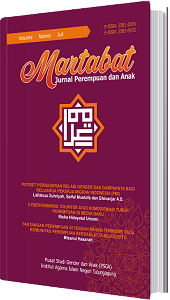Abstract
Lampung Province has several areas which are allegedly conflict-prone areas that have disturbed the social life of the community and have also endangered the lives and property of the victims. In this case, women have a very crucial role, especially in creating social resilience after conflict. This research examines women's strategic role in building post-conflict social resilience in Lampung Province. This research was qualitative research with interviews, observation, and documentation as data collection techniques and source triangulation to test the validity of the data. The results of the research showed that women have a very crucial role in developing post-conflict social resilience in Lampung Province, namely the strategic role of women in the family includes active participation in improving the quality of life and the family economy, educating and instilling the values of tolerance and awareness of diversity in children and increasing insight and awareness of the role of women through participation in social and religious activities. Furthermore, the role of women in society is to support and play an active role in the implementation of social activities, increase the frequency of togetherness activities as a forum for interacting and communicating with each other in differences as well as holding and playing an active role in social activities that are neutral in nature, without being based on ethnic or religious elements. In conclusion, by optimizing the role of women, social resilience in society can be created.
References
Aisyah, St. “Konflik Sosial Dalam Hubunga Antar Umat Beragama.” Jurnal Dakwah Tabligh 15, no. 2 (2014): 189–208. http://journal.uin-alauddin.ac.id/index.php/tabligh/article/view/348/319.
Amory, Jeffriansyah Dwi Sahputra. “Peranan Gender Perempuan Dalam Pembangunan Di Sulawesi Barat Tahun 2016-2018.” GROWTH Jurnal Ilmiah Ekonomi Pembangunan 1, no. 1 (2019): 1–15.
Davronova, Feruza. “Woman and Her Social Status in Public.” Semantic Scholar. Last modified 2020. https://www.semanticscholar.org/paper/Woman-And-Her-Social-Status-In-Public-Activity-Davronova/cfe3213587cc8ff7d107e67d807618c3104d87f7.
Desike, Vivin, Aprilia Audia, and Wardani. “Konflik Antar Masyarakat Etnis Jawa Di Desa Sukaraja Tiga Dan Masyarakat Etnis Lampung Di Desa Gedung Wani Kecamatan Marga Tiga Lampung Timur.” Social Pedagogy 2, no. 1 (2021): 82–95.
Fadzil, Alivia Nur, and Eka Cahya Maulidiyah. “The Effect of Mother’s Parenting Stress on Socio-Emotional Development in Early Childhood.” Martabat: Jurnal Perempuan dan Anak 7, no. 1 (2023): 83–96.
Fahmi, Teuku, and M.Zaimuddin Akbar. “Pemetaan Daerah Rawan Konflik Sosial Di Kabupaten Tanggamus.” Jurnal Sosiologi 17, no. 2 (2015): 111–121.
Goswami, Runali. “Role of Women in Decision-Making in The Family.” Journal of Emerging Technologies and Innovative Research (JETIR) 8, no. 4 (2021): 264–269. https://www.jetir.org/papers/JETIR2104036.pdf.
Indarti, Sri Henny. “Peran Perempuan Dalam Pembangunan Masyarakat.” IJPA 5, no. 1 (2019): 1–12.
Iradat, Taufik, and Haeril Haeril. “Resolusi Konflik Berbasis Pemberdayaan Masyarakat Di Desa Rato Kecamatan Lambu Kabupaten Bima.” Journal of Governance and Local Politics (JGLP) 3, no. 1 (2021): 48–62.
Irwandi, and E. R Chotim. “Analisis Konflik Antara Masyarakat, Pemerintah Dan Swasta (Studi Kasus Di Dusun Sungai Samak, Desa Sungai Samak, Kecamatan Badau, Kabupaten Belitung).” JISPO, 7, no. 2 (2017): 24–42.
Kesbangpol. “Potensi Konflik Provinsi Lampung.” Kesbangpol Provinsi Lampung. Last modified 2014. Accessed February 28, 2022. https://kesbangpol.lampungprov.go.id/.
Kristina, Anita. “Partisipasi Perempuan Dalam Perbaikan Perekonomian Keluarga Dan Masyarakat.” Pamator 3, no. 1 (2010): 69–76.
Lestari, Puji. “Peranan Dan Status Perempuan Dalam Sistem Sosial.” DIMENSIA 5, no. 1 (2011): 45–61.
Padmiati, Etty. “Menuju Masyarakat Berketahanan Sosial Melalui Pemberdayaan Lembaga Sosial Lokal Di Provinsi Kalimantan Tengah.” Jurnal PKS 12, no. 3 (2013): 263 – 275.
Prantiasih, Arbaiyah. “Reposisi Peran Dan Fungsi Perempuan.” Jurnal Pendidikan Pancasila dan Kewarganegaraan 27, no. 1 (2014).
Prayitno, Saputro. “Penanganan Pasca-konflik Sosial Di Lampung Selatan (Studi Pada Wilayah Polda Lampung).” Jurnal Cepalo 3, no. 1 (2019): 35–40.
St. Shofiyah dan Hafidh Canggara. “Penanganan Konflik Ambon Dalam Analisis Dialektics Peace-Reconciliation Dari Bar- Siman-Tov.” Jurnal Al Munzir 16, no. 1 (2023): 33–56. https://ejournal.iainkendari.ac.id/index.php/al-munzir/article/viewFile/6014/2244.
Sugiyono. Metode Penelitian Pendidikan (Pendekatan Kuantitatif, Kualitatif, Dan R&D). Bandung: Alfabeta, 2018.
Suwignyo, Agus, and Rhoma Dwi Aria Yuliantri. “Praktik Kewargaan Sehari-Hari Sebagai Ketahanan Sosial Masyarakat Tahun 1950-an (Sebuah Tinjauan Sejarah),.” Jurnal Ketahanan Nasional 24, no. 1 (2018): 94–116.
Syah, Hidayat. “Penelitian Deskriptif.” Int J Qual Health Care Metode Penelitian Bisnis. Edisi Terjemahan. Jakarta: Penerbit Erlangga, 2014.
Titus, Ray, D Singputa, and S Madan. "A Woman as a Decision-Maker: Exploring the 'Lived Experience Home and Outside.” The Qualitative Report 22, no. 5 (2017): 1379–1394.
Umam, Khotibul. “Membangun Ketahanan Sosial Keluarga Dalam Keberagaman.” Welfare : Jurnal Ilmu Kesejahteraan Sosial 9, no. 1 (2020).
Winter, Browyne. “Women as Cultural Markers/Bearers.” Wiley Online Library. John Wiley and Sons Ltd, 2016. https://onlinelibrary.wiley.com/doi/epdf/10.1002/9781118663219.wbegss695.
Zahrok, Siti. “Peran Perempuan Dalam Keluarga.” In SEMATEKSOS 3"Strategi Pembangunan Nasional Menghadapi Revolusi Industri 4.0, 2018.
Zuhriyah, Lailatuzz. “Perempuan, Pendidikan Dan Arsitek Peradaban Bangsa.” Martabat: Jurnal Perempuan dan Anak 2, no. 2 (2018): 249–268.

This work is licensed under a Creative Commons Attribution-ShareAlike 4.0 International License.

